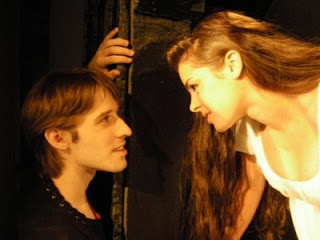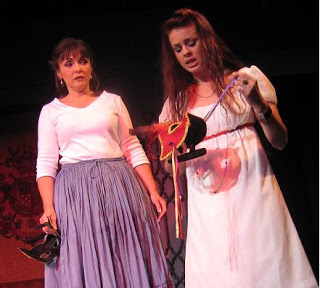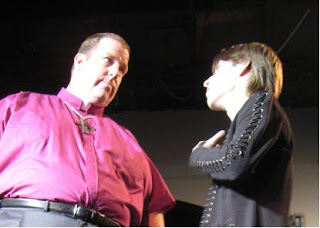Review: Romeo and Juliet by Sam Bass Community Theatre
by Michael Meigs
The Romeo and Juliet now playing at the Sam Bass Community Theatre in Round Rock is a slim, silvery production that clocks in at just about two hours.
Thanks to director Lynn Beaver for taking on the challenge of doing tragedy with this group of dedicated community players, many of whom have taken on multiple management roles to keep this theatre vital. Housed in a simple structure that once served as a Union Pacific depot for the town, the SBTC has been active since the 1970s, operating on the shoestring provided by volunteers, modest business sponsorship and grants such as the $5000 that the Union Pacific provided recently for fixing up the structure.
Director Beaver chose a text prepared and adapted in 2004 by David Hundsness. This is no Reader’s Digest edition. The adapter did a scrupulous, ethical job of fileting the original text, preserving the story line and the essentials of the characters. Almost all of the most memorable lines of verse were retained.
Purists would certainly object to his reducing the text by 30 to 40 percent, adroitly stitching together scenes while adhering to original texts and crafting both a brief marriage scene in Friar Laurence’s chambers and a funeral for Juliet. But none of this diminishes a whit the power of Shakespeare’s language or plot. The adaptation is directly in the centuries-old tradition of moving the bard to the audience.
The company’s effort is all the more laudable because director and actors have paid a great deal of attention to the meaning and syntax of the text as used. Without the brilliant verbosity and extra incident so familiar to readers and playgoers, the actors surprise us with the nuance and directness of Shakespeare’s dialogues.
And the pauses! This cast shows us their feelings and evolving thoughts by using pauses for thought and silent communication, an art all too rare among actors playing the unabridged texts.  Trey Deason as Romeo and CiCi Barone as Juliet are perfectly cast. He joins the awkward angularity of a boy who is almost a man with the moody focus, resolution and edge of desperation of a man wrestling with an impossible love. CiCi Barone moves from sweet simplicity in early scenes to a teasing self-confidence with her suitor Romeo; dismay with her father’s decision to marry her off estranges her from mother and nurse. They see her as a petulant child; Barone’s command of Shakespeare’s text makes it clear to us that she has made choices that determine her destiny.
Trey Deason as Romeo and CiCi Barone as Juliet are perfectly cast. He joins the awkward angularity of a boy who is almost a man with the moody focus, resolution and edge of desperation of a man wrestling with an impossible love. CiCi Barone moves from sweet simplicity in early scenes to a teasing self-confidence with her suitor Romeo; dismay with her father’s decision to marry her off estranges her from mother and nurse. They see her as a petulant child; Barone’s command of Shakespeare’s text makes it clear to us that she has made choices that determine her destiny.
The company locates the action in an imagined contemporary Verona that is closer to Venice, California. The Montague clan wear black and a junior member enters on a skateboard; Capulets, probably from the better side of the tracks, wear white. This easy color coding may help younger audiences and does not obstruct the action.
It does provide a potential difficulty at the Capulet party, where the unwelcome Montagues could hardly be disguised by masks, but we can forgive that. Old Capulet (the gallant and nattily clad Richard Dodwell) is affable enough to overlook a bit of riffraff on the periphery of his party.
Special recognition to some of my other favorites:  Errich Peterson as Benvolio, Romeo’s companion, delivers himself as the voice of reason and counsel. He speaks well and is always an impressive presence.
Errich Peterson as Benvolio, Romeo’s companion, delivers himself as the voice of reason and counsel. He speaks well and is always an impressive presence.
 Deletions in the Hundsness text greatly reduce the role of Juliet’s nurse in exposition and comedy. Hundsness elimates, for example, her lengthy, mawkish tales of Juliet’s upbringing and her lamentation at having only four teeth left in her mouth. Even so, Susan Poe Dickson’s characterization is a gift to us. Instead of a crone, we enjoy a hopeful matchmaker, almost an older sister to Juliet. She sparkles with anticipation of successful romance, teases Juliet to distraction by withholding news of Friar Laurence’s marriage scheme, and becomes distract when calamities begin to pile up. In the original there is much rushing around and consternation after Juliet is found lifeless in her bed; in the Hundsness adaptation all of that is replaced as a smiling Dickson comes to awaken her charge, realizes the situation and cries out, in anguish, “Juliet!!”
Deletions in the Hundsness text greatly reduce the role of Juliet’s nurse in exposition and comedy. Hundsness elimates, for example, her lengthy, mawkish tales of Juliet’s upbringing and her lamentation at having only four teeth left in her mouth. Even so, Susan Poe Dickson’s characterization is a gift to us. Instead of a crone, we enjoy a hopeful matchmaker, almost an older sister to Juliet. She sparkles with anticipation of successful romance, teases Juliet to distraction by withholding news of Friar Laurence’s marriage scheme, and becomes distract when calamities begin to pile up. In the original there is much rushing around and consternation after Juliet is found lifeless in her bed; in the Hundsness adaptation all of that is replaced as a smiling Dickson comes to awaken her charge, realizes the situation and cries out, in anguish, “Juliet!!”
Some casting decisions may have been affected by the availability in this group of female talent. The casting of Amy Lewis as Mercutio provides an unexpected bonus and possibilities. Like any Mercutio she is larger than life, full of humors and quarrelsomeness. But her role as the third wheel while Benvolio seeks to distract Romeo from the stand-offish Rosaline gives extra bite to her mockery of lovers’ dreams of Queen Mab and her dissolute carousing. Mercutio is pulpy, good-looking but not pretty-pretty, but she is completely ignored by Romeo. We can speculate at a back story here.
In this streamlined version the role of Friar Lawrence (Andy Brown) is necessarily more prominent. At crucial moments in the staging, including at the wedding and the funeral, he looms center stage in his distinctive purple shirt and clerical collar. Brown plays the friar as direct and matter-of-fact, rather than as the well-intentioned fumbler often seen. In this version, there is no plague to delay the transport of his letters to Romeo; rather, his messenger simply fails to deliver. Though Hundsness cut Lawrence’s recounting in the final scene of actions gone awry, the director restores enough of it to provide closure and to provide the good friar a moment of confession.
In the final scene the black-white dichotomy of Montague vs. Capulet breaks down. Costuming reinforces the message of reconciliation.
This was an intimate setting for a favorite play. The approachable presentation was accompanied by a warm and personable greeting afterwards, when the cast made it more special still by lining up outside to greet the departing audience members.
Romeo and Juliet
by William Shakespeare
Sam Bass Theatre Association
September 19 - October 11, 2008
